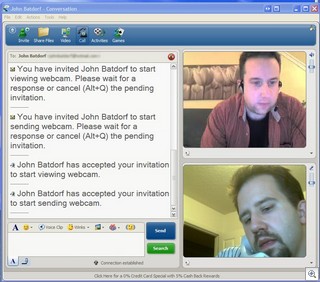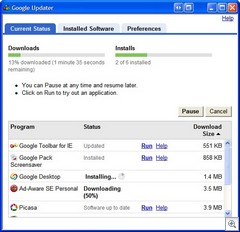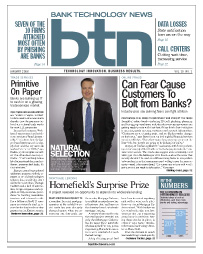2006 is the year of Video Chat

This may be the year of Video Chat. Someone is bound to get it right this year.
Skype totally nailed voice chat last year. Nailed it shut. Seven versions of MSN Messenger tried to get voice chat right and Skype totally nailed it. Now they've released Skype 2.0  and it includes Video. If they nail this, it'll be a happy day for me. I'm all about chat with about 280 folks on Messenger and I'd love to be able to chat with video. Their interface is really very nice and polished. It's no iChat, but it's nice for Windows.
and it includes Video. If they nail this, it'll be a happy day for me. I'm all about chat with about 280 folks on Messenger and I'd love to be able to chat with video. Their interface is really very nice and polished. It's no iChat, but it's nice for Windows.
Now Messenger 8 Beta is out and using invites (ala Gmail) to spread the word. I invited 5 folks. The screen shot at right is me chatting with my buddy John. The audio was iffy, but the video was pretty sweet. There's the Messenger Team's blog that points out a nice new feature of this version: type ahead contact searching.
![]()
As a tangent, I run Large Icons on my systems. Note the pixelly icon for Messenger. I'm REALLY looking forward to scalable icons in Vista. The icons (most) in the current Vista Betas are scalable vectors. I hope this ushers in a renaissance for UI and not the Garish mid-90s when Flash (remember FutureSplash?) was first introduced. Flash really put bad designers into motion. You think a static image sucks? Make it fly across the page and you'll discover what it really means to suck. But, I digress.
Video Chat will happen (and really work this time) in 2006. Google Talk will likely add it. AOLs Instant Messenger "Triton" includes video chat. ICQ5 has video. Gaim-vv will soon do video with MSN and Yahoo.
The real question is this: It's 2005 and why aren't our chat services interoperable? Why is there a market for Trillian? Because folks don't want to get together and standardize. Sure, there's Jabber (XMPP) and there's SILC, but I don't see it sweeping the Windows world. Maybe I'm mistaken.
Can't we all just get along?
Now playing: Freshlyground - Buttercup
About Scott
Scott Hanselman is a former professor, former Chief Architect in finance, now speaker, consultant, father, diabetic, and Microsoft employee. He is a failed stand-up comic, a cornrower, and a book author.
About Newsletter



